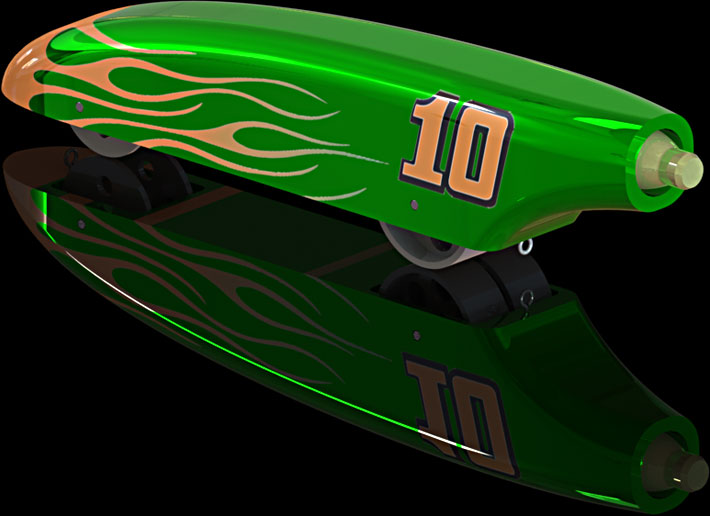Now that I've lured you in with my title.....
It's not a full on dragster....
Not even close really.
I'm in my high school's Technology Student's Association and we have a competition to design and build a miniature CO2 powered dragster.
It'll look something like this:



The Rules are rather extensive so it is essentially a formula spec race.
In essence, the cars will run down a guideline (fishing line) on 4 wheels and the whole dragster is made out of wood.
I've been messing around with Solidworks 2010 a bit and I would like to give a shot at 3D modeling one of these and simulating air flow as well as possibly getting it CNC cut (we have a number of large engineering companies in my town so I think I might be able to ask).
The body length is only 200-305mm so that gives you an idea of its size.
I am very new to working with Solidworks and have little CAD design experience so it will be a learning process. I need to figure out how to make smooth curves. I wonder if there is a trick for sketching a drawing on paper and then scanning the general shape into a 2D drawing on a CAD design.
Any feedback would be awesome. I'm probably going to be using this video series to start as a base for designing. Any tips on specific elements I should incorporate to ensure the fastest car would help tons.
I'm thinking about trying to make it as light as possible, drilling cavities into it, and then filling them as needed with lead solder until I'm right at the minimum weight req.
CNC experts: What wood material would be best for this application? It cannot be laminated in any way.
I'll have to post my CO2 powered school bus I built 10 years ago.
We always just used balsa wood. Cheap, easy to cut, and light. I think using a CNC for the basic shape would be fine, but unless you have access to a cam software that can handle the curves like what you want, I would just cut the main shape out with CNC. Finishing it with hand tools would be less work in the end.
I'd like to CNC the car for you. I competed in a student design competition in 2009 and had a lot of fun while learning a ton.
As for modeling, I'd suggest following tutorials for lofts. Do some simple shapes first and work your way toward the car body.
To sketch smooth shapes, use the spline tool.
They all look too heavy.
I had my Tech Ed students do CO2 cars a ways back.
While most of theirs were freaking bricks that weighed more than the board I gave them, I carved mine down to the absolute minimum of everything allowed in the ruleset we were using at the time.
And the crafty little buggers moved the cushion out of the end when mine went, shattering the thing into pieces.
I still might be a little bitter about that..... (grin)
adoyle88 wrote: I'd like to CNC the car for you. I competed in a student design competition in 2009 and had a lot of fun while learning a ton. As for modeling, I'd suggest following tutorials for lofts. Do some simple shapes first and work your way toward the car body. To sketch smooth shapes, use the spline tool.
Thanks! Your Chevy Cobalt tube chassis build thread has inspired me a bit to learn CAD design
I think easier gains might be had with wheels and axles than aero. You'll want to get ultra-low rolling resistance pizza cutter wheels (seems everyone has these on the front, but fat wheels on the rear for some reason? Maybe directional stability?) and have the most slippery bearings possible...maybe maglev bearings?
GameboyRMH wrote: I think easier gains might be had with wheels and axles than aero. You'll want to get ultra-low rolling resistance pizza cutter wheels (seems everyone has these on the front, but fat wheels on the rear for some reason? Maybe directional stability?) and have the most slippery bearings possible...maybe maglev bearings?
Would there be less friction if you just had it leave the ground?
![]()
ronholm wrote:GameboyRMH wrote: I think easier gains might be had with wheels and axles than aero. You'll want to get ultra-low rolling resistance pizza cutter wheels (seems everyone has these on the front, but fat wheels on the rear for some reason? Maybe directional stability?) and have the most slippery bearings possible...maybe maglev bearings?Would there be less friction if you just had it leave the ground?
Yes! I competed and was a State Judge for TSA for many years. Some of the faster cars actually fell ontheir side and went down the track not on their wheels.
I would definetly make sure only 3 wheels at most touch the ground at the same time. Also, make the wheels spin on the axle AND the axle spin on the car.
Lightweight = good.
Make sure the finish of the car is VERY smooth.
Make sure the wheels are round and roll true. Also make sure the wheels are as thin as they allow.
Good Luck!
You'll need to log in to post.